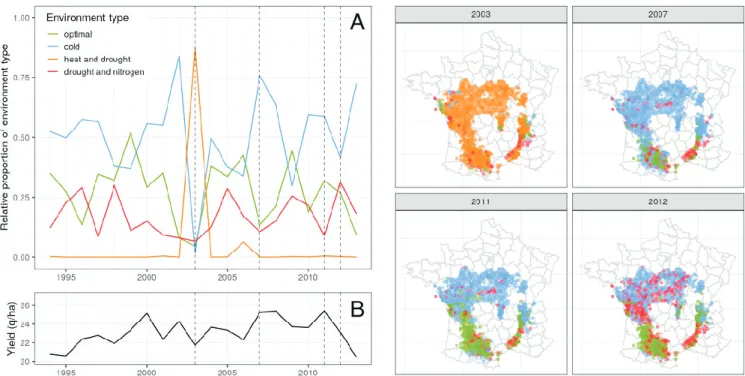HAL Id: hal-02956660
https://hal.inrae.fr/hal-02956660
Submitted on 3 Oct 2020HAL is a multi-disciplinary open access archive for the deposit and dissemination of sci-entific research documents, whether they are pub-lished or not. The documents may come from teaching and research institutions in France or abroad, or from public or private research centers.
L’archive ouverte pluridisciplinaire HAL, est destinée au dépôt et à la diffusion de documents scientifiques de niveau recherche, publiés ou non, émanant des établissements d’enseignement et de recherche français ou étrangers, des laboratoires publics ou privés.
Optimized cultivar deployment improves the efficiency
and stability of sunflower crop production at national
scale
Pierre Casadebaig, Arnaud Gauffreteau, Nicolas Langlade, Mestries
Emmanuelle, Sarron Julien, Trépos Ronan, Philippe Debaeke
To cite this version:
Pierre Casadebaig, Arnaud Gauffreteau, Nicolas Langlade, Mestries Emmanuelle, Sarron Julien, et al.. Optimized cultivar deployment improves the efficiency and stability of sunflower crop produc-tion at naproduc-tional scale. iCROPM 2020 Second Internaproduc-tional Crop Modelling Symposium, Feb 2020, Montpellier, France. pp.125-126. �hal-02956660�
125
Second International
Crop Modelling Symposium February 3-5, 2020Le Corum, Montpellier, France Book of abstracts
iCROPM 2020- oral presentation Session III: linking crop/plant models and genetics
Session III:
linking crop
/plant models and genetics
S3-O.02 Optimized cultivar deployment improves the efficiency and stability of sunflower crop production at national scale.
Casadebaig Pierre1 (pierre.casadebaig@inra.fr), Gauffreteau Arnaud2, Langlade Nicolas3, Mestries Emmanuelle4, Sarron Julien5, Trépos Ronan6, Debaeke Philippe1
1 UMR AGIR, INRA, Castanet-Tolosan, France; 2 UMR Agronomie, INRA, Thiverval-Grignon, France; 3 UMR LIPM, INRA, Castanet-Tolosan,
France; 4 Terres Inovia, Castanet-Tolosan, France; 5 UMR HortSys, CIRAD, Montpellier, France; 6 UR MIAT, INRA, Castanet-Tolosan, France Plant breeding programs design new crop varieties which, while adapted to distinct population of environments, are nevertheless grown over large areas during their commercial life.
Over this global farming area, the crop is exposed to highly diverse stress patterns caused by climatic uncertainty and various management options, that can often lead to decreased crop performance regarding to the expected level (yield gap).
Phenotypic plasticity is defined as the range of phenotypes a single genotype can express as a function of its envi-ronment (Nicotra et al., 2010). At the population level, this process underlies the relative variation in performance of varieties across environments. It is commonly referred as genotype x environment interactions in plant breeding and agronomy and can explain up to 20% of total yield variance observed in multienvironment trials.
In this study, our aim is to assess how a finer spatial management of genetic resources could reduce the geno-typephenotype mismatch in farming environments and ultimately improve the efficiency and stability of crop pro-duction. We used modeling and simulation to predict the crop performance resulting from the interaction between cultivar growth and development, climate and soil conditions, and management actions (Casadebaig et al., 2016). We designed a computational experiment that evaluated the performance of a collection of commercial sunflower cultivars in a realistic population of farming environments in France, built from agricultural surveys (Sarron et al., 2017). Distinct farming locations that shared similar simulated abiotic stress patterns were clustered together (Chenu et al., 2013) to specify environment types (figure 1). Optimization methods were then used to search for cultivars x environments combinations that lead to increased yield expectations.
Results showed that a single cultivar choice adapted to the most frequent cropping environments is a robust strategy. However, the relevance of cultivar recommendations to specific locations was gradually increasing with the knowledge of pedoclimatic conditions. At the national scale, tuning the choice of cultivar impacted crop per-formance the same magnitude as the effect of yearly genetic progress made by breeding.
We argue that this approach, while being operational on current genetic material could act synergistically with plant breeding as more diverse material could allow access to cultivars with distinctive traits that are more adapted to specific conditions.
126
Second International
Crop Modelling Symposium February 3-5, 2020Le Corum, Montpellier, France Book of abstracts
iCROPM 2020- oral presentation Session III: linking crop/plant models and genetics
Session III:
linking crop
/plant models and genetics
Figure 1. Temporal and spatial distribution of environment types. The panel A displays the evolution of the relative proportion of environment types over 20 years. For reference, panel B is the national sunflower yield. The right panels display the spatial distribution of environment types (colors) for each individual farming condition
(dots) of the sampled cropping area, for a subset of four contrasted years.
Keywords: crop management, phenotypic plasticity, modeling, genotypebyenvironment interactions, sunflower crop. References:
1. Casadebaig P, Mestries E, Debaeke P (2016) A modelbased approach to assist variety assessment in sunflower crop. European Journal of Agronomy 81: 92–105. doi: 10.1016/j.eja.2016.09.001.
2. Chenu K, Deihimfard R, Chapman SC (2013) Largescale characterization of drought pattern: A continentwide model-ling approach applied to the Australian wheatbelt–spatial and temporal trends. New Phytologist 198: 801–820. doi: 10.1111/nph.12192.
3. Nicotra AB, Atkin OK, Bonser SP, Davidson AM, Finnegan EJ, Mathesius U, Poot P, Purugganan MD, Richards CL (2010) Plant phenotypic plasticity in a changing climate. Trends in plant science 15(12): 684–692. doi: 10.1016/j. tplants.2010.09.008.
4. Sarron J, Brun F, Casadebaig P, Rollet P, Mestries E, Debaeke P (2017) Diagnostic agronomique des évolutions de rendements du tournesol en france. GISHP2E Eds..
